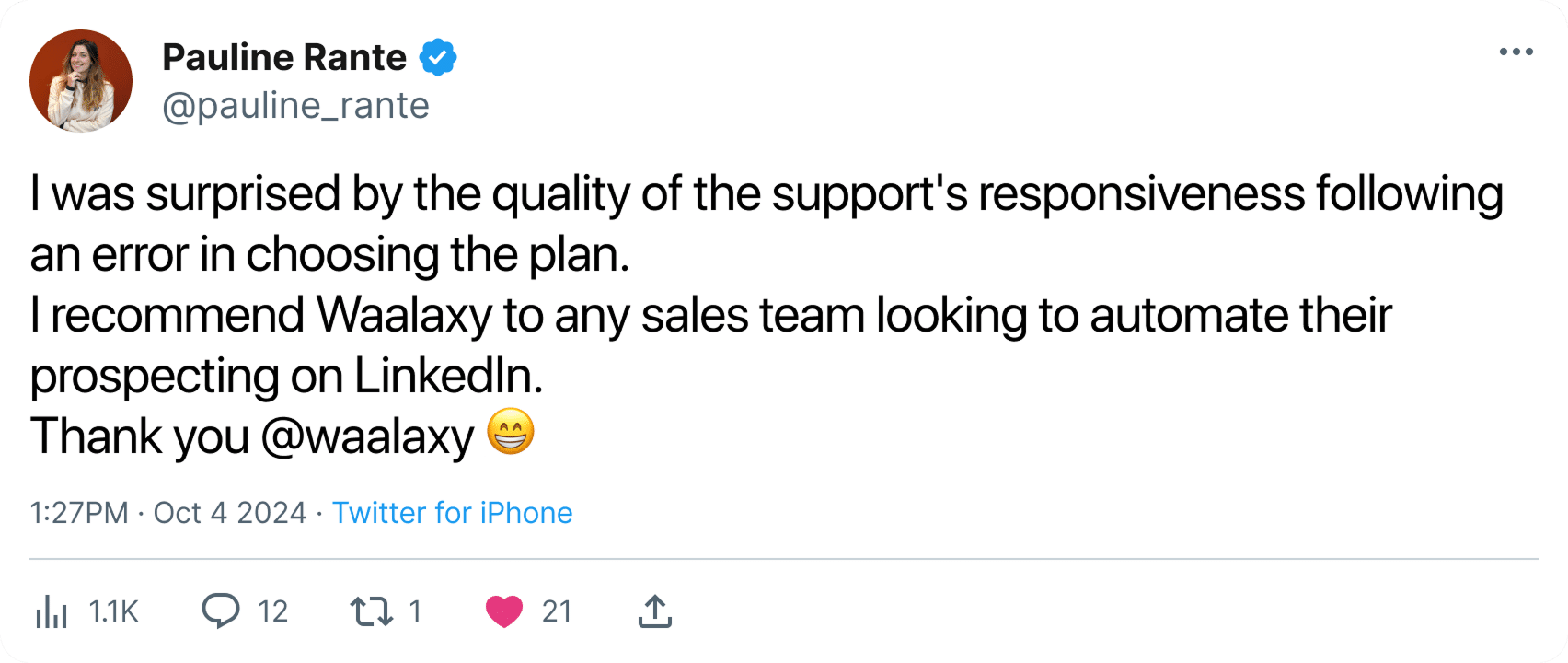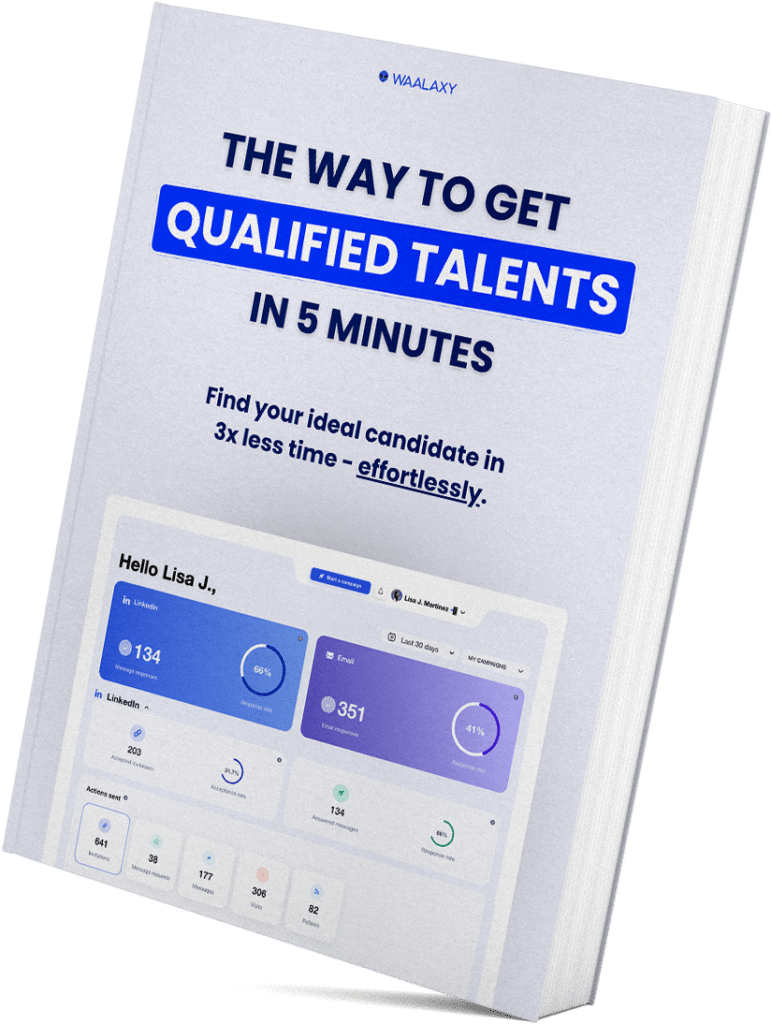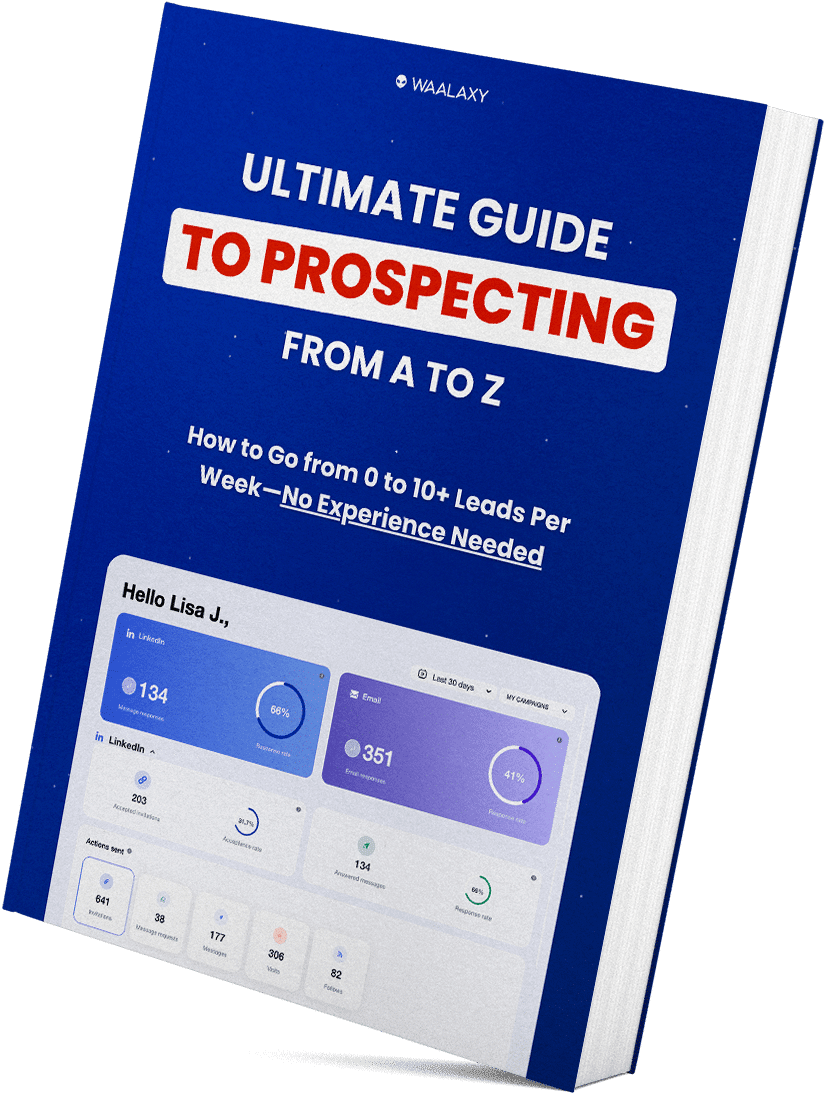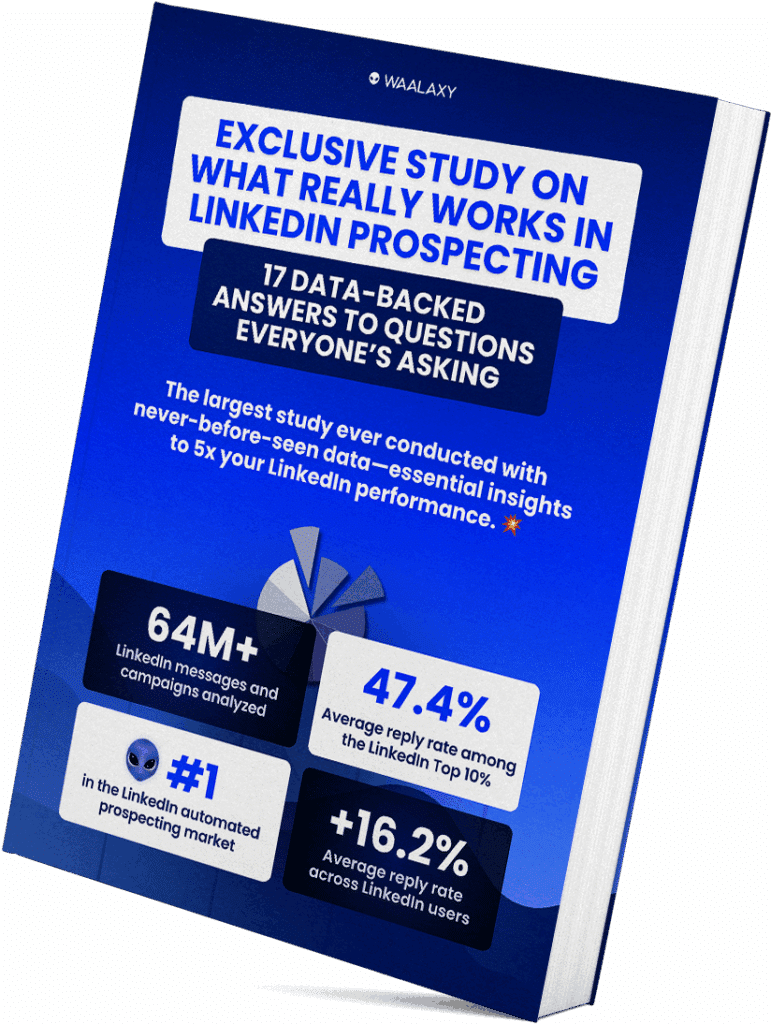Adopting a niche marketing strategy is often the best way to differentiate yourself as a freelancer, consultant or B2B startup. Rather than aiming wide (and vague), you target a precise segment, with a clear message and much more concrete results.
But you still need to know how to find your niche, where to reach it and, above all, how to convert it. 🔁
In this article, we show you how to build a real niche marketing strategy on LinkedIn, with a simple method, concrete niche market examples and tools (like Waalaxy) to automate everything. 👀
Let’s get started! (Reading time: 6 minutes).
What is a niche marketing strategy?
Niche strategy is the art of focusing on a very specific segment of a market, rather than trying to speak to everyone.
In other words, we’re targeting fewer people, but better.
A quick example:
- A generalist CRM ⭢ broad market.
- A CRM designed for independent coaches ⭢ niche market.
Mass marketing relies on volume and visibility, while niche marketing strategy plays the card of specialization and personalization. 🃏
And as you know, it’s hard to keep your target’s attention, so this kind of positioning can make all the difference. 👀
What are the advantages and disadvantages of niche marketing?
Instead of giving you a long speech, what could be better than a table listing the advantages and disadvantages? 👀
| Marketing niche advantages | Marketing niche limits / risks |
|---|---|
| Better targeting You address a specific segment with precise needs, which increases the relevance of your marketing actions. | Small market By targeting a niche that’s too small, you limit your potential customer volume. |
| Less competition You position yourself where few players are present, facilitating visibility and differentiation. | Dependence on a segment If your niche evolves or disappears, you risk having to quickly reposition your offer. |
| Better ROI Better-targeted, more effective campaigns, with less wasted budget and energy. | Barrier to scalability Some niche markets quickly reach their growth ceiling. |
| Enhanced customer relations You speak their language, you understand their problems, so you create a real relationship of trust. | Overly rigid positioning Too much specialization can lock you into a single business perception. |
| More engaging content Your publications and messages resonate better with a well-defined audience. | Risk of isolation If you bet everything on a niche, you’re more vulnerable to market changes. |
Real-life examples of B2B niche marketing strategy
Still haven’t got the hang of it? No problem, we have some niche market ideas for you. 😇
We’ll quickly give you a few B2B niche strategies and niche marketing examples that work:
- A marketing agency targeting law firms only.
- Billing software dedicated to freelancers in the construction industry.
- A LinkedIn consultant specializing in scale-up & candidate sourcing tech profiles.
- A prospecting SaaS (hey Waalaxy) used to contact purchasing managers in the mechanical industry. It’s also a good affiliate marketing niche.
- AI consultants for SMEs and small businesses.
- ESG / CSR specialist for the SaaS sector.
- Cybersecurity consulting for local SMEs and underserved areas.
- Automation consultants for B2B marketing and sales teams.
- Soft skills coach for managers.
- LinkedIn Ads + native content specialists in digital marketing niches.
- “Diversity and inclusion” consulting for tech / SaaS companies.
- “Customer success and retention” specialist for B2B SaaS.
You see, in each case, the offer is designed for a specific audience, with:
- 1️⃣ Specific needs.
- 2️⃣ A language they understand.
- 3️⃣ A clear promise.
Result: less marketing effort for more impact.
Why adopt a niche marketing strategy in 2025?
Today, B2B companies face 3 major challenges:
- Acquisition costs are skyrocketing for traditional channels.
- Competition is fierce, even on the most banal keywords.
- Audiences are solicited everywhere, all the time.
That’s why a niche marketing strategy makes it possible to:
- Reduce marketing costs by targeting more precisely.
- Boost engagement with the right message.
- Position yourself as an expert on a specific subject or target.
- Generate leads that are more qualified and easier to convert.
How to choose a niche market? In short, these days, if you choose the right niche, your brand positioning, your prospecting and your business will be happy 😉
Why is LinkedIn the best platform for a niche marketing strategy?
When it comes to LinkedIn niche marketing strategy, it’s not enough to choose your target well, you need to know where and how to reach it. 💬
And for that, don’t worry, LinkedIn is the most powerful platform in B2B.
Why? 🤔
For starters, it’s the number 1 professional social network in the world, representing over a billion users, no less. 😅
And if that reason isn’t enough for you, here are 3 more. 👇🏼
1) Ultra-precise B2B targeting for LinkedIn niche audiences
LinkedIn’s strength lies mainly in the quality of its data:
- Job titles.
- Business sectors.
- Company sizes.
- Geographic areas.
- Skills.
- Career paths.
Basically, everything you need for a niche audience. 👀
Let’s take a simple example:
You want to target recruitment managers in SaaS with over 200 employees in the Lyon region?
LinkedIn lets you identify them in just a few clicks, without having to go through forms as long as a toy catalog.
I’m teasing you a little, but with a tool like Waalaxy, you can create a targeted list from this search, and launch a personalized campaign. I’m just saying. 🤫
2) Less competition, more visibility in LinkedIn niche sectors
On Google, queries such as “CRM software” are competitive, ultra-saturated by large competitors.
On LinkedIn, it’s just the opposite. The more precise you are in your niche, the more visibility you get.
Why is this? Well, because:
- Algorithms focus on qualitative interactions on a specific topic.
- Few people take the time to talk to a specific niche.
- Targets react better to a message designed for them.
As a result, if you regularly post content dedicated to your niche, or prospect with a personalized message, you’ll stand out from the crowd, without having to spend a peso on advertising 😉
And icing on the cake, your niche is often under-exploited on LinkedIn, so you can quickly build an authority, become the reference on your subject, and thus, attract the right customers. 🧲
3) Optimized ROI thanks to a hyper-personalized approach
Niche marketing strategy is also the art of sending the right message, to the right person, at the right time. And that’s not as easy as it sounds. 😅
But don’t worry, if you use LinkedIn and Waalaxy, you can do it without any worries.
With, you can: 👇🏼
- Market segmentation of your campaigns by profile (HR, Talent Acquisition).
- Adapt your wording according to company size or sector.
- Multiply contact points (connection, message, follow-up).
- Measure what works (response rate, click-through rate, appointment booking rate).
No need to spend hours doing it.
Let me sum it up in a few words:
- You target better.
- You reach people faster.
- You convert more easily.
- You don’t waste budget or energy.
How to find a profitable niche market on LinkedIn ? Step-by-step method
Now that you understand the importance of a niche, let’s get down to the nitty-gritty.
We’ll quickly explain in 4 steps how to find your niche market. 🔎
Step 1: Define your positioning and added value
Before you even open LinkedIn, take the time to ask yourself the following questions:
- What problem are you solving (and for whom precisely)?
- What’s your expertise?
- How are you different from other players in the market?
Simple example:
I’m a web developer ⭢ too broad.
I create conversion tunnels on Webflow for business coaches ⭢ bingo, that’s a niche.
Always think: what skills or experience give me an edge with a certain type of customer?
Step 2: Identify your effective LinkedIn niche audience
Now that you’ve got a clear offer, it’s time to take the plunge and test your presence on LinkedIn. 📝
To do this, don’t hesitate to use the filters in Sales Navigator or Advanced Search:
- Positions ⭢ who are the decision-makers?
- Sectors of activity ⭢ is your offer relevant in a specific field?
- Company size ⭢ VSE, SME, or ETI?
- Location ⭢ are you rather local or national?
For finding the niche market the aim is to validate that there’s a sufficient base of potential customers on the platform. 🌍
You don’t need to have 100,000 of them; if you’re selling a high-end service, 300 well-qualified profiles are enough to build a solid business, believe me.
Step 3: Analyze the competition and validate your successful LinkedIn niche market
You’ve got the idea, that’s great. But now you need to make it profitable. 💸
To do this, do a quick competitive scan on LinkedIn about market niching:
- Who’s already talking to this target?
- What type of content works?
- Are there already many similar offers?
- What’s missing?
Minute tip: look at the posts that generate engagement in your niche ⭢ it gives you clues about pain points and hot prospects.
Finally, make sure your audience has the budget, intention and maturity to buy your solution.
Otherwise, all your efforts will be for nothing… 😔
Step 4: Adapt your communication to your popular LinkedIn niche (content, messages, tone)
Okay, once you’ve validated the niche, you need to talk to them the way they talk:
- What words do they use to describe their business?
- What problems do they encounter on a daily basis?
- What content formats do they consume?
- What levers are they sensitive to (performance, time, image, risk reduction)?
If you contact a DHR and a VSE CEO with the same message, you won’t get any response.
To do this, you can create an editorial line with:
- Posts that address niche issues.
- Prospecting messages adapted to their context.
- A tone that shows you know their needs.
How to prospect effectively a LinkedIn niche marketing strategy?
Now that you’ve got a clear, committed niche, it’s time to move on to prospecting, without spending your days at it, I promise. 😇
1) Create ultra-targeted lists with Waalaxy
The first step is to build a prospect base aligned with your niche. Waalaxy is the perfect tool for this. 👀
With LinkedIn search (classic or via Sales Navigator), you can filter by:
- Specific position.
- Sector.
- Company size.
- Geographical area.
- Seniority or hierarchical level.
Once you’ve defined your criteria, you import these profiles directly into Waalaxy to create a targeted list.
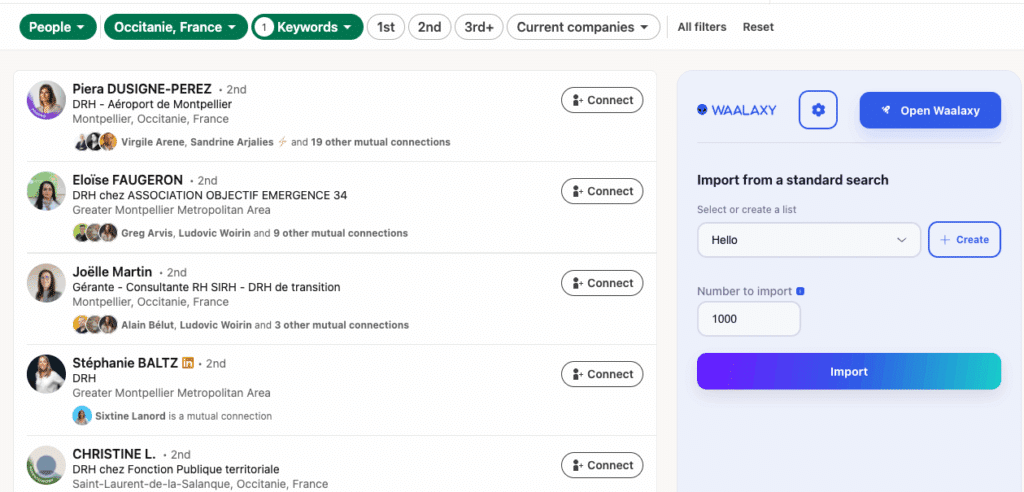
2) Automate multi-channel campaigns without losing personalization
Once you’ve imported your list, it’s time to launch your prospecting campaign, but not just like that!
With Waalaxy, you can: 👇🏼
- Create automated sequences: invitation, message 1, reminder 1, message 2, etc.
- Add personalized delays between each step.
- Alternate between LinkedIn and e-mail.
- Manage multiple campaigns according to your segments.
Each message can be personalized with name, position or company.
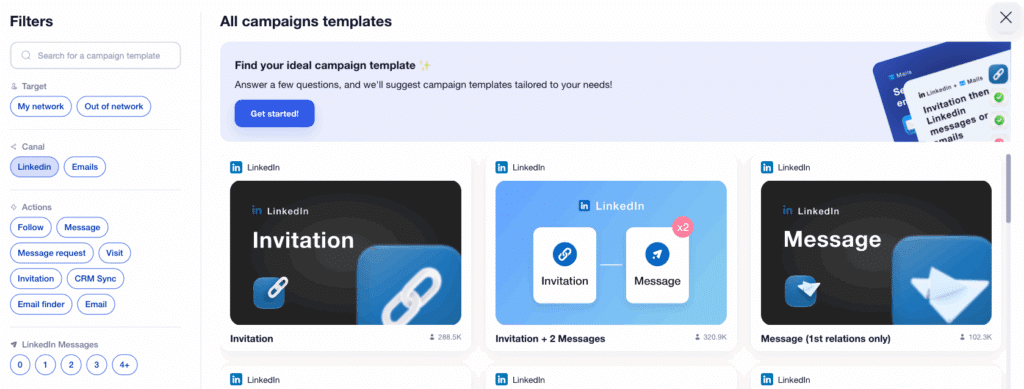
3) Personalize your messages according to your identified LinkedIn niche
In my opinion, this is the most important step, the one that makes all the difference. We’ve had enough of cardboard prospecting messages, we want messages made of gold. ⭐️
❌ Bad example:
Hello, I’m contacting you because I offer marketing services.
✅ Message focused for your LinkedIn niche:
Hi {{firstName}},
I wanted to ask you a question since you work in {{company}}.
What takes up the most of your time today on resume processing?
I’d be interested to know how you operate.
It’s not just more pleasant to read, it’s what makes the message read, understood and generates a response.
Remember, with a niche marketing strategy, you have few targets, so every interaction counts.
It’s not just more pleasant to read: it’s what makes the message read, understood and generates a response.
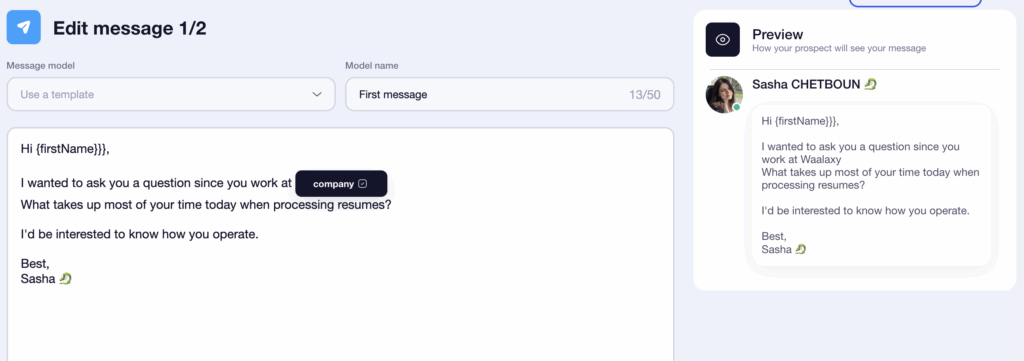
4) Measuring the performance (KPIs) of a niche marketing strategy
To find out whether your niche marketing strategy is working, we recommend you track these indicators: 👇🏼
- LinkedIn invitation acceptance rate.
- Message response rate.
- Number of appointments obtained.
- Transformation rate (lead ⭢ customer).
- Time spent vs value generated.
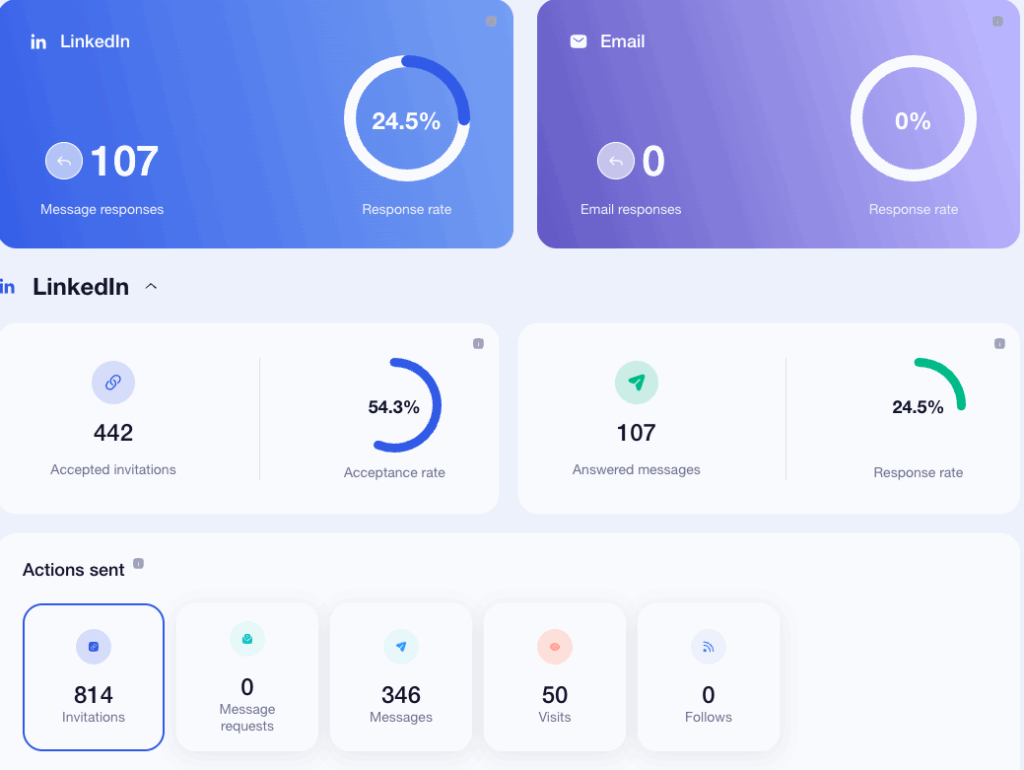
To your delight, Waalaxy lets you track all this, campaign by campaign.
With a LinkedIn niche, you can also A/B test your messages, so you’ll know which message stands out.
How about a recap?
You can keep aiming wide, posting for everyone and sending the same messages to every CEO in United States.
But between you and me, you know it doesn’t work anymore. 😔
And no, nesting doesn’t mean limiting, it means: 👇🏼
- Be identified quickly.
- Become a reference on a specific subject.
- Increase response rate.
- Reduce marketing costs.
- Convert better.
Now, ask yourself this final question ⭢ would you rather try to convince everyone, or attract those who already need you? 🤔
If you’re up for it, then LinkedIn and Waalaxy are your best allies.
You’ve got the targets, you’ve got the tools, you’ve got the method, all that’s left is to take action.
How do you define a niche?
Defining a niche means first of all identifying a specific market segment, with clear needs, a target and a suitable offer. 📇
It’s not just about narrowing down your target for the sake of it, it’s also about defining where competition is low but demand is high.
To do this, ask yourself these 3 questions:
- Who do you want to reach (sector, function, company size).
- What specific problem can you solve for them?
- What makes you legitimate or not?
A good LinkedIn niche is a target that you understand better than the average, and to whom you can speak directly. If you have to force the issue, it’s because the niche isn’t yet clear.
What are the 3 main marketing strategies?
There are 3 main approaches to market:
- 1️⃣ The mass strategy (undifferentiated outreach marketing) ⭢ we speak to everyone, with a broad message.
- 2️⃣ The differentiated strategy ⭢ we segment the niche market into several targets, with a message tailored to each.
- 3️⃣ The niche marketing strategy (or concentration)⭢ we focus on a segment, often neglected by the main players.
All 3 strategies are valid. But you need to choose the one that suits your size, resources and objectives.
What is a niche product?
A niche product is designed to meet a very specific need, often poorly represented to the public. 👀
Unlike mainstream products that target a broad audience, a niche product focuses on a limited but well-defined segment (a community, a profession, a specific use, an issue). 💬
Here are some examples of niche products:
- A billing software for freelancers in construction.
- An emailing tool designed for therapists.
- A mobile app dedicated to sports dietitians.
- Tech accessories for musicians.
And if you didn’t know, a good niche product is often characterized by:
- A high conversion rate ⭢ because it speaks to a target audience that feels engaged.
- Less competition ⭢ because few players address this target.
- A clear positioning, making it easier to market.
You have to find the right product for the right audience, at the right time.
Now you know all about niche marketing strategy. See you soon! 👋


